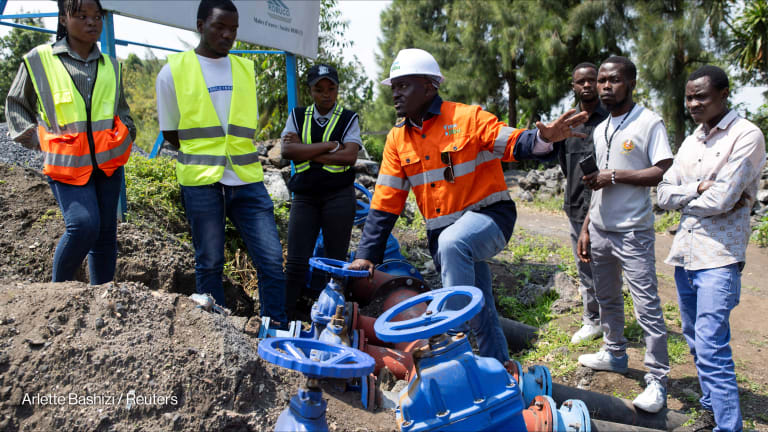
The U.S. Agency for International Development and the Department of Defense are coordinating to support a “massive logistical operation” to move food, supplies and rescue workers in and local residents out of areas ravaged by Super Typhoon Haiyan in the Philippines.
The storm has affected 11.3 million people in the central Visayas region, according to the latest U.N. estimates.
On Tuesday, the world body issued a $301 million appeal to cover direct humanitarian needs over the next six months, of which $38 million has been received so far.
Up to $25 million has come from the Central Emergency Response Fund, a pooled funding mechanism for the United Nations, said Karen Smith, program officer at the Office for the Coordination of Humanitarian Affairs, during an information call at the U.S. Chamber of Commerce Foundation’s Business Civic Leadership Center in Washington, D.C.
USAID has committed $20 million, half of which will be channeled through the World Food Program to deliver emergency food aid. In addition, the agency already completed on Tuesday its first airlift of heavy-duty plastic sheeting to Manila. A total of 55 metric tons of emergency food products — including enough bars and pastes containing a day’s worth of calories to sustain 20,000 children and 15,000 adults for four to five days — are expected to be flown to disaster-affected areas later this week.
“You may be seeing reports on the news about the difficulty in moving aid; what you’re not seeing is the massive logistical operation that’s quickly standing up to get this aid to those in need,” said Laura Meissner, technical adviser at USAID’s Office of U.S. Foreign Disaster Assistance, who was also on the call.
The operation draws on heavy support from the U.S. military’s Pacific Command, highlighted Monday by Secretary of State John Kerry’s order that the aircraft carrier USS George Washington make “best speed” to the Philippines, together with the 80 aircraft and 5,000 sailors it carries. The aircraft carrier, according to regional political affairs officer Lt. Col. Brad Bartelt, should arrive as early as Thursday and will supply 11 Marine MB22 Osprey helicopters that are particularly well-suited to reach more difficult to access, outlying areas that have been cut off from aid so far.
About 250 additional U.S. military personnel have already been deployed to the Philippines to distribute more than 107,000 pounds of relief supplies, including food and water, provided by the Philippine government, USAID, Canada and Australia, Bartelt added.
Cluster system
The United Nations recently underwent a humanitarian reform effort to clarify roles and responsibilities amid relief operations across agencies and between local and international nongovernmental organizations. That reform effort created the so-called “cluster system,” which is being implemented in the current relief operation.
The cluster system breaks down relief operations by sector and assigns a lead agency to each of them. For example, UNICEF acts as the lead agency for education, while WFP is in charge of food security efforts. The U.N.’s Humanitarian Action Plan likewise lists the NGOs that are working within the relief effort by cluster, and each cluster is coordinated both globally from Geneva and at the field level during a humanitarian operation.
The system is designed “to ensure we’re coordinating all responses, hitting priority needs and … not replicating efforts,” said Smith. It also holds relief efforts up to “sphere” minimum quality standards for those who deliver the aid.
Many participants on the information call agreed the biggest challenge continues to be gathering accurate information to inform relief operations.
“We don’t know what we don’t know yet,” admitted Bartelt.
Communication infrastructure is still down in many areas, though 50 percent of cellphone services have been restored in the hardest-hit main city of Tacloban, Leyte, noted Bill Brindley, CEO and executive director of NetHope.
Brindley said that communications technology giants Cisco and Microsoft are both providing engineers on the ground or from home bases to support the re-establishment of a communications network. Some relief workers are also being dispatched with satellite communications equipment.
Other companies and individuals have rushed to lend their support too, but the officials stressed the best way for most people to make a positive impact is also the most straightforward: send cash.
“[I want] to underline as many times as I can, the best approach is to work with reputable, experienced groups and … provide cash assistance,” Richard Hough, USAID senior development adviser to the Pacific Command, said.
The officials urged concerned citizens and potential corporate donors to visit USAID’s Center for International Disaster Information to learn more about ways to contribute.
Read more development aid news online, and subscribe to The Development Newswire to receive top international development headlines from the world’s leading donors, news sources and opinion leaders — emailed to you FREE every business day.
See more:








